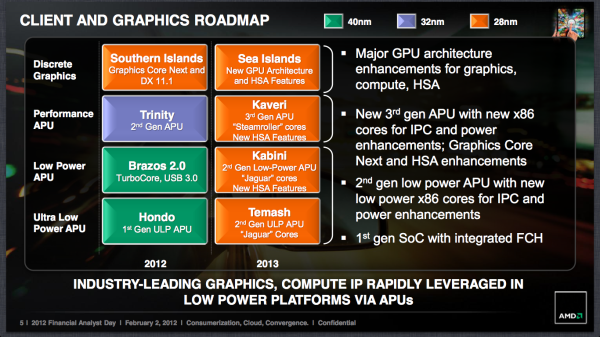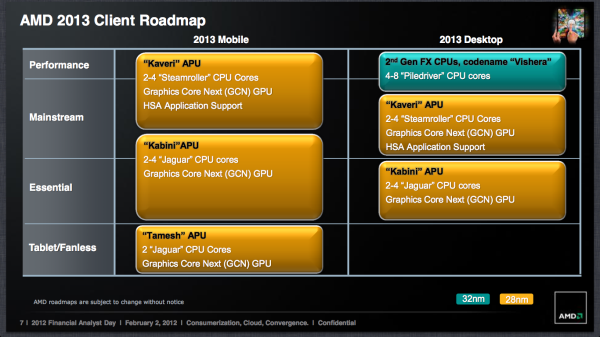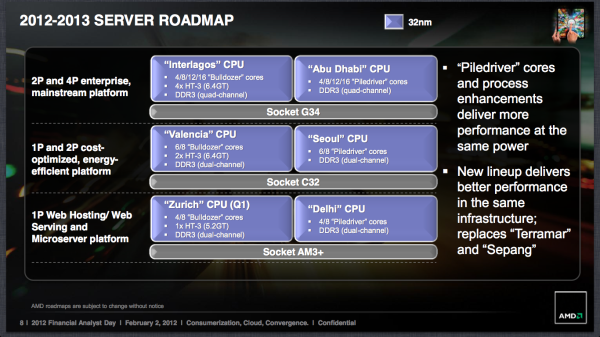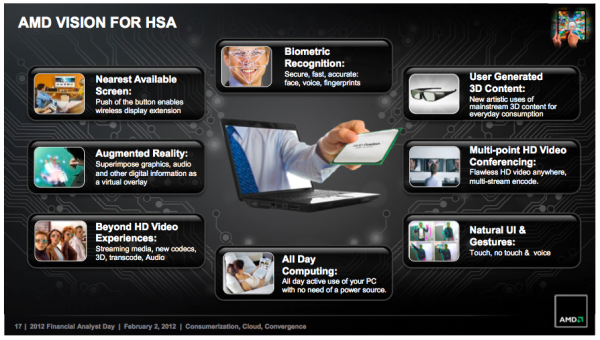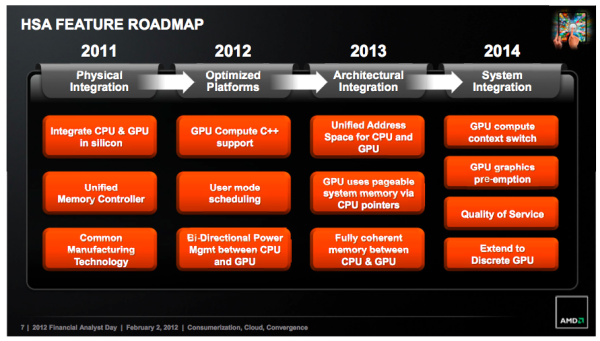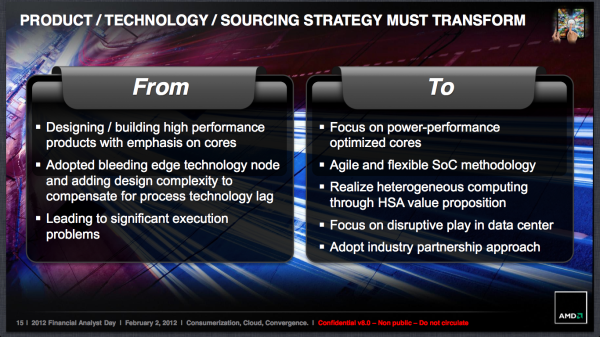
Original Link: https://www.anandtech.com/show/5503/understanding-amds-roadmap-new-direction
Understanding AMD's Roadmap & New Direction
by Anand Lal Shimpi on February 2, 2012 6:16 PM EST- Posted in
- CPUs
- AMD
- Trade Shows
- AMD FAD 2012
We've been providing live coverage of AMD's 2012 Financial Analyst Day from Santa Clara today, but if you want a summary of the company's strategy under new CEO Rory Read you've come to the right place. Below you'll find links to everything we've published from AMD's FAD 2012:
AMD's Rory Read Outlines AMD's Future Strategy
AMD Outlines HSA Roadmap: Unified Memory for CPU/GPU in 2013, HSA GPUs in 2014
AMD is Open to Integrating 3rd Party IP in Future SoCs
AMD's Financial Analyst Day 2012 - Mark Papermaster, SVP & CTO Presentation
AMD: Flexible Around ISA
AMD Nods at Shorter Design Cycles, More Synthesized Designs
What AMD Views as Important: Tablets, Servers, Notebooks & GPUs
AMD & Compal Show Off 18mm Trinity Notebook
AMD's 2012 - 2013 Client CPU/GPU/APU Roadmap Revealed
AMD's 2012 - 2013 Server Roadmap: Abu Dhabi, Seoul & Delhi CPUs
AMD is Ambidextrous, Not Married to Any One Architecture, ARM in the Datacenter?
AMD's Tablet Architectures: Hondo at 4.5W, Future Sub-2W SoC
The name of the game for AMD in 2012 is execution. Far too often at previous AMD events we'd see a roadmap with no indication of whether or not AMD would actually stick to it. Plans were always aggressive and made sense, but execution rarely mirrored what was promised on paper. AMD in turn ended up delivering CPUs sometimes years after they were promised, which obviously didn't help grow the company.
Over the past few months Rory and his new management team at AMD have been restructuring the company to improve execution. As a much smaller company than Intel, AMD had an almost impossible task competing in the x86 space, but AMD should have also been far more agile than it was given its size. AMD's restructuring is supposed to fix these agility and execution problems. The proof will be in how well AMD is able to introduce products over the next 24 months.
As far as the roadmap goes, AMD already laid out what it hopes to accomplish by 2013. The best way to summarize AMD's next two years is: APUs and servers. On the APU side, we'll get updates to all of the current lines this year (Trinity & Brazos 2.0), but we'll also get a new 4.5W APU (Hondo) aimed at the Windows 8 tablet market. Now 4.5W is a bit high for a tablet but AMD has plans to bring even lower power architectures to market in the future. Next year we'll also see the first single-chip solutions from AMD: Kabini and Temash will integrate the I/O controller (SATA, USB ports, etc...) on-die. Intel is doing something similar with Haswell.
The big transition will happen next year, as AMD moves its entire APU stack from 32nm SOI to a bulk 28nm process at Global Foundries. This is an important move as it signifies the use of more easily synthesized designs, which enables AMD to bring out APUs in a quicker fashion and with lower design costs. Effectively everything follows the path laid by Brazos/Bobcat at this point. Note that AMD will be shipping 28nm APUs while Intel is well transitioned to 22nm, a gap that AMD has no intentions on narrowing. The process technology gap has almost always existed between AMD and Intel, but now AMD is taking a firm stance in saying that it has no intentions to blindly pursue the closing of that gap.
What once was a 3+ year design cycle for AMD CPUs and APUs now shrinks to less than 24 months (maybe even as short as 18 months) as a result of this migration to more easily synthesized designs. If this sounds a lot to you like the old GPU design cadence don't be surprised. AMD's APUs are, after all, largely made of GPU transistors that have always strayed from custom logic where possible. The big change is simply doing more non-custom x86 design.
Obviously AMD's ability to execute on this roadmap will depend heavily on Global Foundries delivering good yields at 28nm, however AMD does seem fairly confident at this point. That being said, 2013 is a very broad timeframe. Executing on the above roadmap sooner rather than later in 2013 will be the difference between a competitive AMD and one that's quickly written off.
I don't believe a move towards easily synthesized architectures is necessarily a bad thing. As long as AMD can deliver good performance at competitive prices the process technology really doesn't matter as much. Typically process technology was used as an enabler of good performance but as a newly fabless semiconductor, that strategy doesn't necessarily apply to AMD - at least not across all market segments. In other words, what works for Intel may not work for AMD.
The New Focus: Client Mobility
For years we had asked for lower power AMD mobile solutions. While we finally started seeing some progress over the past couple of years, AMD is now very committed to building mobile devices. Anything tablet sized or above is now AMD's target for client APUs.
AMD was always the high-end x86 CPU alternative to Intel in the PC space, now AMD is going to be the alternative in the ultra mobile space.
Servers & the High End Desktop
AMD's server roadmap for the next two years is a bit more conservative. We'll see Piledriver updates from top to bottom but there's no significant departure from the way things are done today. There are no plans for any new sockets in the near term, just using existing platforms to grow AMD's server marketshare without huge new investments.
As AMD's client strategy is predominantly built around APUs, the only high-end desktop parts we'll see from AMD are low-end server CPUs. Socket-AM3+ has a future for one more generation and we'll likely see other single-socket, high-end platforms for the desktop. The days of AMD chasing Intel for the high-end desktop market are done though. That war is officially over.
The Ace: HSA
AMD isn't going to have the fastest general purpose x86 CPUs on the market and it is no longer interested in pursuing that goal. It does promise to have much better on-die GPU performance than Intel. For users today that's primarily an advantage in 3D gaming. As more workloads shift to the GPU however, AMD could have a significant advantage here. The problem is that seamlessly scheduling client workloads across CPUs and GPUs just hasn't happened, the two islands of compute horsepower have remained discrete - even on the new wave of integrated APUs.
AMD's Heterogenous Systems Architecture (HSA) plans to change that. AMD wants to see the creation of a virtual ISA that will be the backbone of a software layer that can schedule application workloads on any combination of underlying CPU/GPU hardware, regardless of the ISA of the hardware. If you have a workload that's best run on big, general purpose x86 cores, that's where it will run. If a task is better designed for highly parallel GPUs cores, it'll run there. And presumably if you had an ARM core somewhere underneath and the workload would run better on it, you'd be covered as well.
AMD plans on delivering an HSA enabled GPU family by 2014, with today's Graphics Core Next GPUs being an intermediary step that already fill a number of these goals. These HSA GPUs would be able to share the same memory space as CPUs and work seamlessly as coprocessors. Granted AMD doesn't have the best track record of quickly moving the industry with things like HSA (although AMD64 did work out quite well), so we'll have to wait and see how all of this plays out.
If AMD can get broad industry support for HSA then its APUs become much more attractive. The overall performance of AMD solutions would then become more compelling as they'd take both CPU and GPU architectures into account, again assuming the workloads require both.
ARM & The Future
Thankfully, Rory isn't HPing the company. AMD will continue to build its own x86 CPUs and GCN (and future) GPUs. The difference is that AMD will now consider, where it makes sense, using other architectures. AMD didn't come out and say it, but it's clear that the other ISA under consideration is designed by ARM. In the markets where it makes sense, AMD might deliver an ARM based solution. In others it may deliver an x86 based solution. The choice is up to the market and customer, and AMD is willing to provide either.
What's most interesting is that AMD was very clear about not wanting to be in the smartphone market. It believes, at least today, that the smartphone SoC market is too low margin to make financial sense. With smartphone SoCs selling for under $20 and given how hard it has been for Intel and NVIDIA to break into that market, I don't blame AMD for wanting to sit this one out. However, smartphones have been a huge success for ARM. If AMD is to offer ARM based SoCs coupled with their own CPU/GPU IP in other markets, it's unclear what the reception will be. The flexibility is definitely appreciated and it's a far more defensible position than saying that all future products have to use x86, but simply embracing ARM isn't a guarantee for success.
Rory Read presented a vision of the future where a large, vertically integrated device manufacturer may want to deliver custom silicon for everything from tablets to notebooks to TVs. AMD's goal is to be able to provide silicon to companies like this, while differentiating based on its own internal IP (x86 CPUs, GPU cores). One current example would be Microsoft's Xbox 360. AMD designed much of the silicon for that console, although it's using 3rd party CPU IP. In other words, should a customer want an ARM based solution mated with an AMD GPU, they could have one. If a customer wanted a strange x86/ARM APU, that would be a possibility as well.
AMD did a good job outlining that it would be more agile and flexible, however it didn't outline what specific products we'd see that implement this new architecture agnostic mentality. I suspect AMD's lack of specific examples is a result of the simple fact that the new management team has only been in place for a handful of months. It will take a while to develop outlines for the first products and a clear roadmap going forward. Until then, it's all about executing on the APU, GPU and server CPU fronts.

